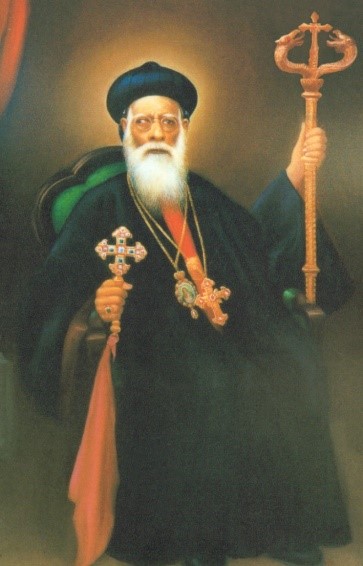

Thirumeni was born on 21st October 1858 in Vattasseril family of Mallappally. He was ordained a deacon by the Patriarch of Antioch, HH Ignatius Peter IV in 1876. He studied in the Old Seminary at Kottayam for four years. He trained under St. Parumala Thirumeni and became a scholar in the Syriac language. He also acted as Parumala Thirumeni’s secretary during this period. Later in 1890, he was ordained a priest by St. Parumala Thirumeni.
He was a man of prayer, in the same way that he learned from his “guru” – Parumala Thirumeni. Later on, this life of prayer helped him to navigate the church through the turbulent storms caused by the administrative intrusion by the Patriarch of Antioch, HH Ignatius Abdulla.
Malankara Association of 1902 decided to elevate Fr. Geevarghese among others to the office of a bishop. Accordingly, the party travelled to Jerusalem and the then Patriarch of Antioch, HH Ignatius Abdulla. He was consecrated as a bishop with the name Geevarghese Mar Dionysius, with the responsibility of Malankara church in general and the assistant of the Malankara Metropolitan. The new bishop was denied the “Sthathikon” by the Patriarch because the new bishop was not ready to admit the temporal authority of the Patriarch over the Malankara Church. In 1911, he was appointed the Malankara Metropolitan following the passing away of the Malankara Metropolitan, Dionysius V.
His tenure as the Malankara Metropolian saw the church split into two factions – one supporting the Malankara Metran and the other supporting the Patriarch. Vattasseril Thirumeni’s prayerful life, intellectual thinking and courage helped the church to move forward even during those difficult times. There was times when the enemies tried to harm his life and the mercenary was not able to fulfil his work seeing the Thirumeni’s tearful prayers during the wee hours of the night. During another incident, Thirumeni’s body guard, known commonly as Ana Pappy was murdered. Thirumeni was fearless and continued to fight for the church and its autonomy.
The biggest achievement of Vattasseril Thirumeni was the establishment of the Catholicate in Malankara in 1912, without which the Malankara Church wouldn’t have existsed as an independent church today. Thirumeni drafted the constitution of the church that was passed in 1934. This document became the backbone of all the legal litigations and is being proven even to this day, which the adversaries of the church cant break through.
The excellent example of Thirumeni’s deep knowledge in the faith and doctrine of the church is the compilation of the book titled “Mathopadesa Saarangal” (Quintessence of Religious Doctrines) in 1908. It is still the “go – to” reference to know the explanation and scriptural background of our faith.
Thirumeni entered eternal rest on February 21st, 1934, and was entombed in the Old Seminary, Kottayam, which witnessed the key events of his eventful life. HH Baselios Geevarghese 2nd, who was the Catholicose said during the service that “When we look at the highest solemn position held by Vattasseril Thirumeni and his deep and firm faith in God, he seemed like Moses who led the sons of Abraham from the captive land of Egypt to the promised land of freedom and happiness. There is no doubt about it. Moses had spent his entire life for the freedom of his people, but he could not enter the Promised Land. He was only able to see the Promised Land from a distance. Likewise, the Moses of the Malankara Church has also watched the freedom of his Church from a distance”.
As a recognition to his prayerful and saintly life, the church canonized him as a saint on 24th February 2003 by HH Baselios Marthoma Mathews 2nd, the then Catholicose. And in recognition to his contribution to the church, the title “Malankara Sabha Bhasuran” or “The Great Luminiary of the Malankara Church” was given to him.
He is indeed the great luminary of our church. On his tomb, HH Baselios Geevarghese 2nd inscribed, “Time will not dim his glory”. These words still echo today.
